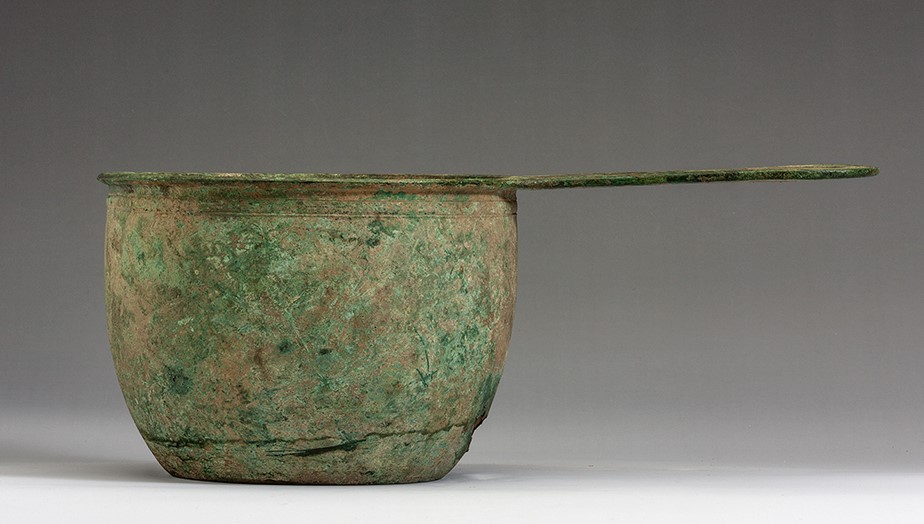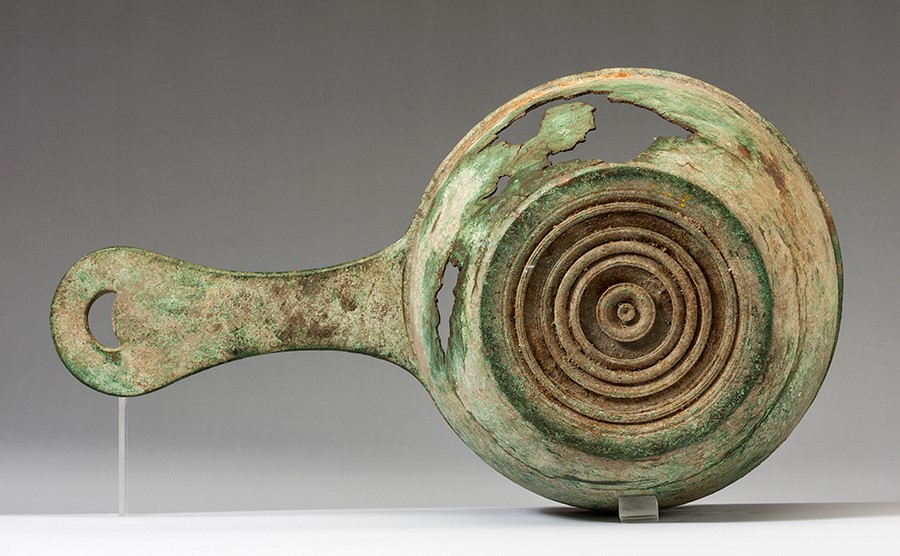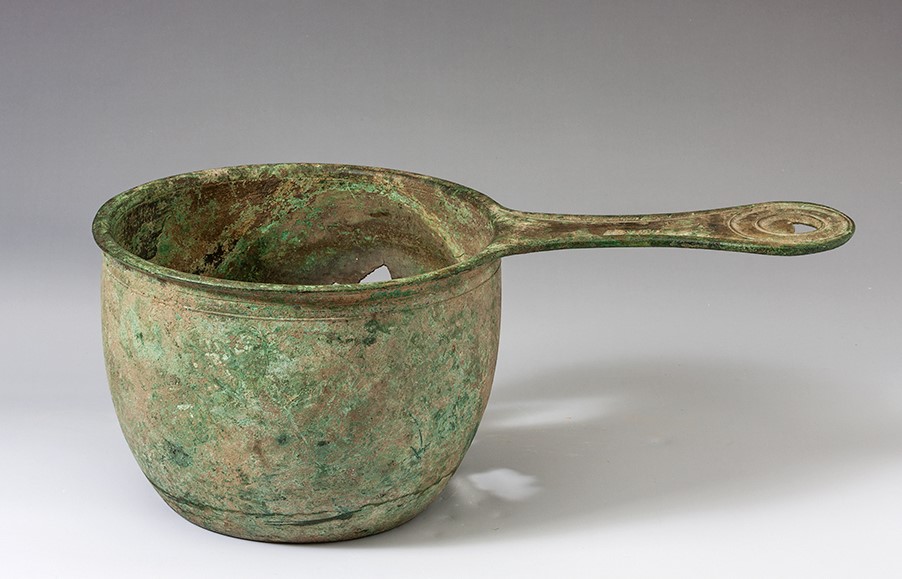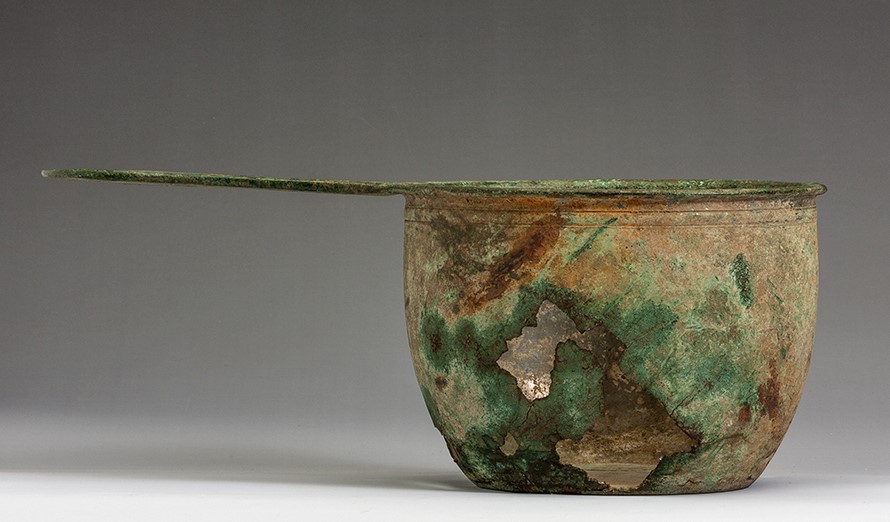Acquisition number: 1981.06
The pan has a deep form with slightly curving sides, coming in more strongly towards the base. The lip is thickened and out-turned, and is continued into the handle. The handle is flat, with a flattened ridge along the edges. It terminates with a hanging-hole set in a circle outlined by ridges; the hole itself is crescent-shaped.
The outer face of the pan is decorated below the lip with a raised band with a decorative motif which it is difficult to make out (wreath?). On the inside, there is an incised line within the lip and, at the bottom, a circular area offset by a ridge and groove, and in the centre a small circle. The underside is elaborately finished with deeply-cut concentric circles.
Title: Bronze Pan - 1981.06
Acquisition number: 1981.06
Author or editor: J.R. Green
Culture or period: Roman Imperial
Date: c. 1st - 2nd century AD.
Material: Metal - Bronze
Object type: Vessels
Dimensions: 422mm (l) × 235mm (w) × 165mm (h)
Origin region or location: Italy
Display case or on loan: 11
Keywords: Roman, Imperial, Pan
Sotheby (London), Sale Cat., 8 December 1980, no. 268.
1981.06
Bronze Pan
Purchased. Ht of bowl 16.5cm; diam. lip 23.5cm; length incl. handle 42.2cm.
In fair condition: there are horizontal cracks towards the base and some parts of the lower wall are missing. The surface is in general is somewhat corroded, with accretions. There is also some surface wear on the top of the handle.
The pan has a deep form with slightly curving sides, coming in more strongly towards the base. The lip is thickened and out-turned, and is continued into the handle. The handle is flat, with a flattened ridge along the edges. It terminates with a hanging-hole set in a circle outlined by ridges; the hole itself is crescent-shaped.
The outer face of the pan is decorated below the lip with a raised band with a decorative motif which it is difficult to make out (wreath?). On the inside, there is an incised line within the lip and, at the bottom, a circular area offset by a ridge and groove, and in the centre a small circle. The underside is elaborately finished with deeply-cut concentric circles.
The fundamental publication on these vessels is H. Willers, Neue Untersuchungen über die römische Bronzeindustrie von Capua und von Niedergermanien (Hanover-Leipzig 1907). For other pans of this general type, see A. Carandini, “Alcune forme di vasellame bronzeo”, in: L’instrumentum domesticum di Ercolano e Pompei (Rome 1977) 163-168, with pll. 76-87, or the series illustrated in M.R. Boriello et al., Le collezioni del Museo Nazionale di Napoli. I Mosaici etc. (Rome 1986) 176-7. For a useful grave-group from Lübsow, not far from the Baltic coast, which included two vessels of this type, see Kaiser Augustus und die verlorene Republik (Exhib.Cat. Berlin, 1988) 571-4 no. 398. See also S. Tassinari, La vaisselle de bronze romaine et provinciale au Musée des Antiquités Nationale (Gallia Suppl. 29, Paris 1975) 16-19 and pll. 1-2; S. Boucher and S. Tassinari, Bronzes antiques du Musée de la Civilisation Gallo-Romaine à Lyon (Lyons 1976) 116-118 nos 131-133, and the still useful article by G. Ekholm, “Die Bronzekasserollen mit Schwanenkopfbügel und ihre Entstehung”, ActaArch 13, 1942, 203-215. Ours seems likely to be post-Pompeian but nonetheless relatively early and it should date to the first or second century AD.
There are useful observations on their possible classification by E. Poulsen, “Remarks on Roman Bronze Skillets with Deep Grooves under the Base” in: S.T.A.M. Mols et al. (eds.), Acta of the 12th International Congress on Ancient Bronzes, Nijmegen 1992 (Nederlandse archeologische rapporten 18, Amersfoort 1995) 59-67.
Vessels such as this were cast and then lathe-finished, and, despite the pan’s condition, one can see evidence of it in the handling of the line within the lip as well as in the decoration of the underside: see A. Mutz, Die Kunst des Metalldrehens bei den Römern. Interpretationen antiker Arbeitsverfahren auf Grund von Werkspuren (Basle-Stuttgart 1972) 71ff. (he prefers to see them as cast), and P. Craddock and J. Lang, “Spinning, Turning, Polishing”, Historical Metallurgy 17, 1983, 79-81. For a recent study of a more elaborate variety, see S. Bender et al., “Neue Forschungen zu den Trau-Kasserollen”, in: Palatinuus Illustrandus. Festschrift für Helmut Bernhard zum 65. Geburtstag (Mainz – Ruhpolding 2013) 69-92.
Despite the common name of pan or casserole, the use of these vessels is not fully certain. Ours has no traces of blackening from cooking; nor do others. They are found in both military and domestic contexts and must have had some function in the collection and distribution of liquids.
Sotheby (London), Sale Cat., 8 December 1980, no. 268.




